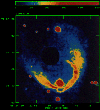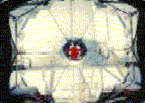Astronomy research at Fresno State is carried out by Professor Ringwald and his
students. It is mainly about cataclysmic variable binary stars
(CVs) and related objects such as novae and black holes, their evolution,
and the physics of their accretion disks and outflows. For an easy primer
on "What is a nova?," see here. For a
more detailed primer on CVs, see here.
 My
Ph. D. thesis was the first optically selected population study
of CVs. It was selected by color, and not by the behavior of these stars'
outbursts, which had biased previous surveys. The space density found, 6
× 10-6 pc-3, suggested a larger-than-expected
fraction of the lowest-luminosity objects. I have since been publishing
detailed studies of individual systems. (Painting by Dana Berry, Space Telescope Science Institute)
My
Ph. D. thesis was the first optically selected population study
of CVs. It was selected by color, and not by the behavior of these stars'
outbursts, which had biased previous surveys. The space density found, 6
× 10-6 pc-3, suggested a larger-than-expected
fraction of the lowest-luminosity objects. I have since been publishing
detailed studies of individual systems. (Painting by Dana Berry, Space Telescope Science Institute)
 Along the way,
John Thorstensen and I identified a new class of faint nova-likes,
with mysterious, but consistent behavior. John named them the
SW Sex stars, and much has been made of them since. They probably
aren't physically different from other CVs, "just" being deeply eclipsing.
Still, it is just this high inclination that reveals their properties,
since explained as from disk outflow and the stream-disk interaction by Coel Hellier, although
questions remain about magnetic
propellers and the role of mass loss.
Along the way,
John Thorstensen and I identified a new class of faint nova-likes,
with mysterious, but consistent behavior. John named them the
SW Sex stars, and much has been made of them since. They probably
aren't physically different from other CVs, "just" being deeply eclipsing.
Still, it is just this high inclination that reveals their properties,
since explained as from disk outflow and the stream-disk interaction by Coel Hellier, although
questions remain about magnetic
propellers and the role of mass loss.
 Another by-product of the survey was finding interesting objects
previously misclassified as CVs. One was PG 1002+506, a
high-latitude Be
star I found with Robert Rolleston, Rex Saffer, and
John
Thorstensen. If on the main sequence, as befits a Be star, it's over
10 kpc above the Galactic plane! How did such a young star get
there? Was it flung out of the Galaxy? Or did it somehow form in
the halo? (The simulation of a rapidly rotating Be star and the disk it
extrudes is from Owocki,
Cranmer, & Blondin 1994, ApJ, 424, 887.)
Another by-product of the survey was finding interesting objects
previously misclassified as CVs. One was PG 1002+506, a
high-latitude Be
star I found with Robert Rolleston, Rex Saffer, and
John
Thorstensen. If on the main sequence, as befits a Be star, it's over
10 kpc above the Galactic plane! How did such a young star get
there? Was it flung out of the Galaxy? Or did it somehow form in
the halo? (The simulation of a rapidly rotating Be star and the disk it
extrudes is from Owocki,
Cranmer, & Blondin 1994, ApJ, 424, 887.)

My second CV population study, with Tim Naylor and
Koji Mukai,
was a spectroscopic atlas of classical novae with outbursts between
1783 and 1986. The spectra were taken to see evolution over decades or
centuries. They show little evidence of nova hibernation, or of any
changes at all, aside from fading of the nebular lines. Old novae look
remarkably similar to each other, except for effects wholly attributable
to their orbital inclinations. (Hubble Space
Telescope image by F. Paresce)
 BZ Cam, long called just 0623+71, or "the one in the
bow-shock nebula" (image by
Hollis et al.), was the first CV found with an optical spectrum
revealing a wind from its accretion disk, shown by intermittent P Cygni
profiles in its H alpha and He I 5876 Å lines. I used William Herschel Telescope
to obtain time-resolved spectra of these lines
with 0.04 nm/pixel dispersion and 30-second time resolution. They
revealed the acceleration law in a CV wind for the first time, a
linear acceleration to 1700 km/s in 6 to 8 minutes. They also showed a
subsequent linear deceleration in 30 to 40 minutes, perhaps an effect of
dilution of the wind as it expands and cools. No periodicity from
rotational outflow is obvious. Raman Prinja, Christian Knigge, and I
extended this study into the ultraviolet, with Hubble Space Telescope's Goddard High Resolution
Spectrograph.
BZ Cam, long called just 0623+71, or "the one in the
bow-shock nebula" (image by
Hollis et al.), was the first CV found with an optical spectrum
revealing a wind from its accretion disk, shown by intermittent P Cygni
profiles in its H alpha and He I 5876 Å lines. I used William Herschel Telescope
to obtain time-resolved spectra of these lines
with 0.04 nm/pixel dispersion and 30-second time resolution. They
revealed the acceleration law in a CV wind for the first time, a
linear acceleration to 1700 km/s in 6 to 8 minutes. They also showed a
subsequent linear deceleration in 30 to 40 minutes, perhaps an effect of
dilution of the wind as it expands and cools. No periodicity from
rotational outflow is obvious. Raman Prinja, Christian Knigge, and I
extended this study into the ultraviolet, with Hubble Space Telescope's Goddard High Resolution
Spectrograph.
 In
collaboration with Koji
Mukai, we used Chandra X-ray
Observatory to observe the origin of the soft X-rays in the old
nova DQ
Herculis. We found that the X-rays are from a point-like source and
show a shallow partial eclipse. We interpret this as due to scattering of
the unseen central X-ray source, probably in an accretion disk wind. DQ
Her is a prototype of a class of stars, the
Intermediate Polars. Click
here for a painting of the disrupted disk of one of these systems by
Mark Garlick.
In
collaboration with Koji
Mukai, we used Chandra X-ray
Observatory to observe the origin of the soft X-rays in the old
nova DQ
Herculis. We found that the X-rays are from a point-like source and
show a shallow partial eclipse. We interpret this as due to scattering of
the unseen central X-ray source, probably in an accretion disk wind. DQ
Her is a prototype of a class of stars, the
Intermediate Polars. Click
here for a painting of the disrupted disk of one of these systems by
Mark Garlick.
 In collaboration with Knox Long, Cyndi Froning, Raman Prinja, and Christian Knigge, I was
involved in a project with NASA's
Far Ultraviolet Spectroscopic Explorer (FUSE) spacecraft. This
project is similar to the one mentioned above with Hubble Space Telescope, although we
had a brighter target, the nova-like variable RW Sextantis. Observing in
the far ultraviolet allowed us to detect the Lyman lines and other
indicators of variability in the accretion disk's wind.
In collaboration with Knox Long, Cyndi Froning, Raman Prinja, and Christian Knigge, I was
involved in a project with NASA's
Far Ultraviolet Spectroscopic Explorer (FUSE) spacecraft. This
project is similar to the one mentioned above with Hubble Space Telescope, although we
had a brighter target, the nova-like variable RW Sextantis. Observing in
the far ultraviolet allowed us to detect the Lyman lines and other
indicators of variability in the accretion disk's wind.

In collaboration
with Steve Saar, Gaitee Hussain, Chris Johns-Krull, I had a run on Keck I, at the time the largest
telescope on Earth, on Mauna Kea, Hawaii.
The objective was to see if the
low states in cataclysmic variables such as VY Scl are caused by
spots on the mass-losing secondary stars.

Steve Saar, Vinay Kashyap, and I
extended these observations with Hubble
Space Telescope, to detect ultraviolet emission lines excited by
the magnetism of the mass-losing secondary star of the polar system, AM
Herculis. We did indeed find evidence for strong
magnetism near L1.

Also with Hubble Space Telescope, a snapshot
survey of nova shells, which are the gaseous, resolved nebular
remnants expelled by classical novae. The snapshots were brief exposures,
taken a few at a time between larger projects, to make the best use of
telescope time. It proved "rather successful" for discovering nova
shells, with ten previously unknown shells found among 32 novae observed.
Shown here are the nova shells of QU Vul (Nova Vul 1984 #2) (left) and
V351 Pup (Nova Pup 1991) (right).

Searches for Thorne-Zytkow objects, red
supergiants with neutron stars in their centers. For all we know, Betelgeuse might be one (Hubble Space
Telescope image by A. Dupree).

Studies of detached post-common envelope binaries: the image is by Mark Somers, and shows the cool
companion's heated face coming and going, as it orbits the hot white
dwarf. Here you can get my star catalog of stars from this
program, ``Composite-Spectrum and Related Stars That
Are Candidate Detached Post-Common-Envelope Binaries, v. 2.3.''

Time-resolved photometry of
detached post-common envelope binaries, to search for irradiation
variations, ellipsoidal variations, and eclipses (with Fresno State
graduate students Simon Gonzalez and Patrick Hinrichs)

Searches for variability in hot
subdwarf stars, such as from pulsations, or from eclipses, irradiation
variations, or ellipsoidal variations in binary systems, or possibly from
unrecognized and misclassified cataclysmic variables (with Fresno State
graduate student Melissa Blacketer)

Time-resolved photometry of
X-ray binaries, including the outbursts of soft X-ray transients/black
hole candidates (with Fresno State graduate student Dillon
Trelawny, Priyansh Joshi, and Fresno State undergraduate Andres Tuteliers
)

Time-resolved photometry of
cataclysmic variables, including the discovery of apsidal superhumps and nodal
superhumps in several systems (with Fresno State students Kenia
Velasco, Jonathan Roveto, Michelle Meyers, Jerry Rude, and Dillon
Trelawny)

Searches for
superflares
and related chromospheric activity in solar-like stars,
suspected to be enhanced by magnetized planets such as hot Jupiters
(with Fresno State graduate students Randy Clark, Jerry Rude, Dillon
Trelawny, Armando Guerrero, and Sourav Kharat)
Long-term light curves from the new generation of automated telescopes and citizen
scientists (with Fresno State graduate students Kylee Ford, Kurt Shults, Eric Goeken, E'lisa
Lee, Chance Spencer, and Fernanda Pilla Bardela)
Last updated 2024 October 29. Web page by Professor Ringwald
(ringwald[at]csufresno.edu),
Department of Physics, California State University,
Fresno. Please read this disclaimer.
 My
Ph. D. thesis was the first optically selected population study
of CVs. It was selected by color, and not by the behavior of these stars'
outbursts, which had biased previous surveys. The space density found, 6
× 10-6 pc-3, suggested a larger-than-expected
fraction of the lowest-luminosity objects. I have since been publishing
detailed studies of individual systems. (Painting by Dana Berry, Space Telescope Science Institute)
My
Ph. D. thesis was the first optically selected population study
of CVs. It was selected by color, and not by the behavior of these stars'
outbursts, which had biased previous surveys. The space density found, 6
× 10-6 pc-3, suggested a larger-than-expected
fraction of the lowest-luminosity objects. I have since been publishing
detailed studies of individual systems. (Painting by Dana Berry, Space Telescope Science Institute)















